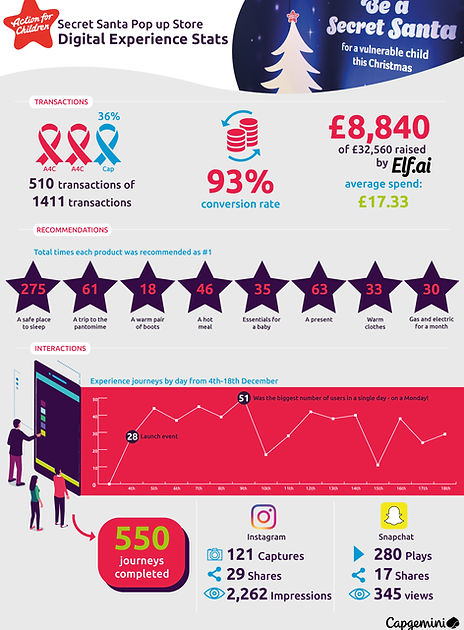
2019
Brief:
Create a digital experience within a pop-up store, which will drive footfall and increase donations
Experience designer
Role:
Illustration, experience design, set design
Activities:

Background
After a successful summer residency, co-locating with Action for Children's innovation team, they asked us to support them in their Secret Santa Christmas campaign which involved setting up a pop-up shop in the heart of Covent garden. The shop would sell Action for Children merchandise, and offer an immersive winter wonderland experience to raise money and provide gifts for children in need.
Our solution
We created a digital AI experience that uses emotion recognition to identify what type of gift a customer should purchase, based on their reaction to a series of Christmas themed images/gifs

Ideation
We ran a workshop to have a short discovery of what other pop-ups are doing, and then began brainstorming to decide what kind of experience we wanted to create. We only had 6 weeks from when the retail unit was confirmed to launch date, and it was full steam ahead. No pressure.


Journey mapping
We settled on a facial recognition based touchscreen product, that surfaces a select number of GIFs taken from various classic Christmas films and TV series, and based on the users' emotional reaction suggests one of the gifts to purchase for a vulnerable child. Once the gift was recommended, supporters pick up the relevant tag and head to the till to pay.
Branding
As we had received branding guidelines from Action for Children, we already had the look and feel requirements for all assets involved in the UI. I began create illustrations.
We also realised we needed to name our experience so the press could differentiate it from the rest of the store. We held a session to do this collaboratively, and settled on Elf.ai





Instagram/Snapchat filter
To help the pop-up store spread the word and gain more reach through social media, we created an Instagram and Snapchat face filter to turn supporters into Secret Santa themselves.
Physical experience
Now we had the digital journey nailed down, the design team split in 2. I headed to the store to measure up and design the physical space that would house the digital screen, and my colleague started wireframing the digital solution. The developers also started training the machine learning model with our support.
I took some photos and started sketching out what it could look like, keeping in mind the brand guidelines Action for Children's marketing team had provided.
.png)
.jpg)
Once my designs were approved, we painted one of the walls to mimic a starry sky, and I enlisted a company who could provide a large touchscreen and wall to support it. They gave me dimensions for artwork to be printed on to the wall. This created an immersive space in a corner of the overall shop. I wanted our space to stand out from the rest of the shop, which was designed to a winter wonderland theme.
User testing
We ran user testing workshops with a paper mock up of the screen housing, to ensure that the touchscreen was in the right place, and the interaction was suitable for people of varying heights. We also had to check that the camera capturing emotional responses was at the appropriate height. Based on insights derived in the session, we made appropriate iterations.
Once the wall was signed off, I sent over the wall artwork and it was installed in store



